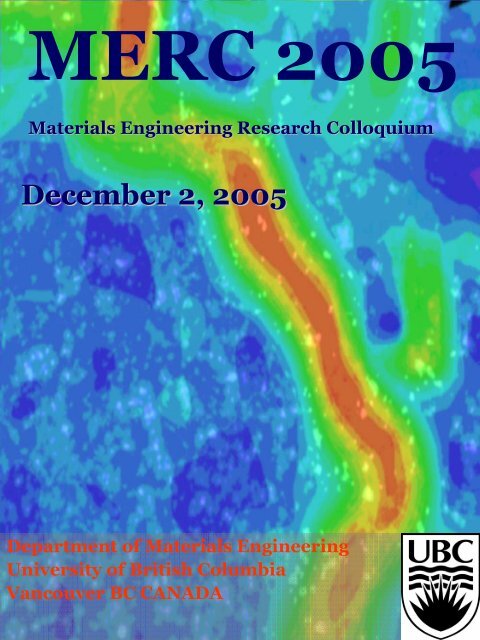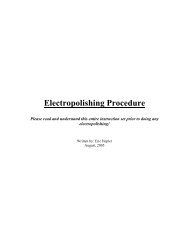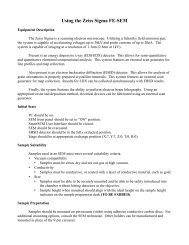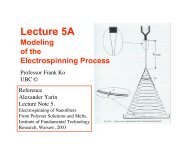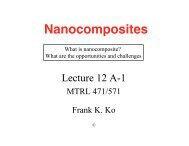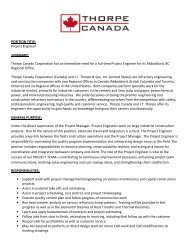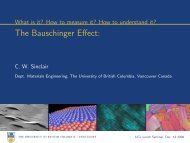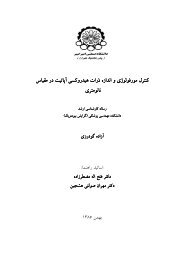December 2nd, 2005 - Materials Engineering - University of British ...
December 2nd, 2005 - Materials Engineering - University of British ...
December 2nd, 2005 - Materials Engineering - University of British ...
Create successful ePaper yourself
Turn your PDF publications into a flip-book with our unique Google optimized e-Paper software.
MERC <strong>2005</strong><br />
<strong>Materials</strong> <strong>Engineering</strong> Research Colloquium<br />
<strong>December</strong> 2, <strong>2005</strong><br />
Department <strong>of</strong> <strong>Materials</strong> <strong>Engineering</strong><br />
<strong>University</strong> <strong>of</strong> <strong>British</strong> Columbia<br />
Vancouver BC CANADA
<strong>Materials</strong> <strong>Engineering</strong> Research Colloquium<br />
Schedule<br />
<strong>December</strong> 2, <strong>2005</strong><br />
Presenter<br />
Title<br />
Session I: (10:00 am – 11:00 am)<br />
Y. Zhang Metals Processing Continuous scrap melting in an oxy-fuel-fired rotary furnace<br />
M. Tsui Ceramics Electrochemical deposition <strong>of</strong> calcium phosphate coating on<br />
coronary stent<br />
L. Silva Biomaterials Nanomechanical characterization <strong>of</strong> cortical bone quality<br />
Session II: (11:15 – 12:15)<br />
G. Malkhuuz Hydrometallurgy Use <strong>of</strong> strong brine and HCL solutions to process sulphide<br />
concentrates with an emphasis on nickel sulfides and associated<br />
gang<br />
A. Chaudhary Metals Processing Modelling constitutive behaviour <strong>of</strong> aluminum alloys during DC<br />
casting at below solidus temperatures<br />
J. Mitchell Metals Processing Determination <strong>of</strong> strain during hot tearing by image correlation<br />
LUNCH (12:15 – 13:15)<br />
Session III: (13:15 – 14:15)<br />
S. Hedge Microstructural<br />
<strong>Engineering</strong><br />
High temperature oxidation behaviour <strong>of</strong> single crystal superalloy,<br />
CMSX-10<br />
F. Xie Hydrometallurgy Catalytic leaching <strong>of</strong> silver ore with dissolved ferric cyanide<br />
D. Mayne Hydrometallurgy Galvanic effect between chalcopyrite and pyrite in atmospheric<br />
leaching
MERC<strong>2005</strong> <strong>December</strong>, <strong>2005</strong><br />
Continuous Scrap Melting in an Oxy-Fuel-Fired Rotary Furnace<br />
Yanjun Zhang<br />
Metals Processing Group; T.R. Meadowcr<strong>of</strong>t and P.V. Barr<br />
Frank Forward Building, Room 401<br />
Department <strong>of</strong> Metals and <strong>Materials</strong> <strong>Engineering</strong>, <strong>University</strong> <strong>of</strong> <strong>British</strong> Columbia<br />
Research Summary:<br />
Cheap hydrocarbon fuels will be the main energy source for high temperature melting in<br />
the future. However, the configuration <strong>of</strong> electric arc furnaces (EAF) is not optimal to<br />
efficiently utilize hydrocarbon energy inputs. Rotary melting furnaces (RMF) are common<br />
in the foundry industry. Although competitive with the EAF in terms <strong>of</strong> thermal efficiency,<br />
they remain batch processes with relatively low melting rates. Recently a new process<br />
for continuous scrap melting in an oxy-fuel-fired RMF has been proposed with sufficient<br />
melting capacity to replace the EAF in minimill steel operations. Model-generated results<br />
indicate that the process can save "at-source" energy by up to 50%. However, the<br />
process has not been physically demonstrated at any scale.<br />
The focus <strong>of</strong> the current work is to demonstrate the feasibility <strong>of</strong> the process at a benchscale<br />
and gather data sufficient for validation <strong>of</strong> an improved mathematical model to be<br />
developed as part <strong>of</strong> the project. The validated model would then be used to predict the<br />
performance <strong>of</strong> an industrial-scale operation. In order to investigate the effects <strong>of</strong> oxygen<br />
and slag on thermal efficiency, two groups <strong>of</strong> trials have been performed for continuous<br />
melting copper at rates up to 25 kg/h. Copper, rather than iron or steel, was chosen for<br />
improved safety (Cu being relatively noble) while still <strong>of</strong>fering a melting temperature at<br />
least approaching that <strong>of</strong> steel. As shown in Figure1 (a), the thermal efficiency increased<br />
almost linearly with increasing oxygen level, while it decreased with increasing <strong>of</strong> slag<br />
thickness (Figure 1 (b)). For the industrial-scale RMF fired with 100% oxygen, the<br />
thermal efficiency can be expected to be 70% or more due to the enlarged freeboard<br />
volume and surface area for heat transfer.<br />
(a)<br />
(b)<br />
Figure 1: (a) The thermal efficiency versus oxygen level (no slag was applied), (b) The effect <strong>of</strong><br />
slag thickness on the thermal efficiency (the baseline oxygen level was 53.0%)
MERC<strong>2005</strong> <strong>December</strong>, <strong>2005</strong><br />
Electrochemical deposition <strong>of</strong> calcium phosphate coating on<br />
coronary stent<br />
Manus Tsui<br />
Ceramics Group; Tom Troczynski<br />
Frank Forward Building, Room 106A<br />
Department <strong>of</strong> Metals and <strong>Materials</strong> <strong>Engineering</strong>, <strong>University</strong> <strong>of</strong> <strong>British</strong> Columbia<br />
Research Summary:<br />
Coronary artery disease (CAD) is a condition caused by thickening <strong>of</strong> the artery walls<br />
that supply blood to the heart muscle. Fatty deposits or plaques may build up inside the<br />
artery wall blocking the blood flow. When these arteries become blocked, the heart is<br />
deprived <strong>of</strong> oxygen and can become damaged. Severe cases can result in heart attack.<br />
CAD is the leading causes <strong>of</strong> death in North America, 54% <strong>of</strong> all cardiovascular deaths<br />
are due to coronary artery disease. Coronary stenting technique is widely used to battle<br />
CAD. Coronary stents are small metallic spring-like implantable device. When<br />
implanted, the stent act as a scaffold to keep the artery open. However, bare metallic<br />
stent may trigger inflammatory response that lead to restenosis- the artery becomes<br />
blocked again. A thin coating, such as hydroxyapatite (HAp) can provide a<br />
biocompatible environment between the stent and the artery. Calcium phosphate<br />
ceramics, especially hydroxyapatite, have gained much attention in clinically application<br />
due to their excellent biocompatibility. Among different methods for producing HAp<br />
coating, electrochemical deposition (ECD) was used to deposit a uniform thin film<br />
coating (0.5 µm) on coronary stents. XRD results demonstrated that hydroxyapatite was<br />
the main component <strong>of</strong> the coating deposited. In vitro stent expansion studies confirm<br />
that the thin film coating show good adhesion without detachment. The thin film HAp<br />
coating also exhibit a highly porous morphology, which is ideal for the next generation<br />
drug eluting stent technology. Future experiments will focus on quantitative analysis <strong>of</strong><br />
adhesive strength, co-deposition technique, and drug eluting capability.<br />
Figure Caption - SEM micrographs <strong>of</strong> stainless steel stent deposited with CaP via<br />
electrochemical deposition.
MERC<strong>2005</strong> <strong>December</strong>, <strong>2005</strong><br />
Nanomechanical Characterization <strong>of</strong> Cortical Bone Quality<br />
Leandro De Macedo Soares Silva<br />
Biomaterials Group; Rizhi Wang and Thomas Oxland<br />
Frank Forward Building, Room 412<br />
Department <strong>of</strong> Metals and <strong>Materials</strong> <strong>Engineering</strong>, <strong>University</strong> <strong>of</strong> <strong>British</strong> Columbia<br />
Research Summary:<br />
Bone is a composite material composed <strong>of</strong> collagen, carbonated apatite mineral, water,<br />
and other non-collagenous proteins. The bone structure inside human body is under<br />
constant remodelling. The mechanical properties <strong>of</strong> bone and their dynamic changes<br />
during remodelling are crucial to the health and quality <strong>of</strong> life.<br />
Bone quality depends on three factors that will be investigated during this research,<br />
namely: mechanical properties characterization by Nanoindentation, measurement <strong>of</strong> the<br />
degree <strong>of</strong> bone mineralization by Quantitative Backscattered Electron Imaging (qBSEi),<br />
and measurement <strong>of</strong> the degree <strong>of</strong> cortical bone porosity also evaluated by<br />
Backscattered Electron Imaging (BSEi).<br />
The main objective <strong>of</strong> this work is to relate clinical evaluation <strong>of</strong> bone health to laboratory<br />
measurements <strong>of</strong> bone structure and properties.The understanding and combination <strong>of</strong><br />
these three parameters enable a more reliable and accurate reading <strong>of</strong> clinical<br />
evaluative tools such as Peripheral Quantitative Computed Tomography (pQCT), largely<br />
used in bone health diagnosis.<br />
Fifteen human tibias were measured and the results will be presented along with a twoway<br />
repeated measures analysis <strong>of</strong> variance (ANOVA).<br />
The mechanical properties <strong>of</strong> bone are intrinsically dependent on the measurement<br />
conditions. The degree <strong>of</strong> mineralization also affects bone mechanical properties. The<br />
mechanical properties <strong>of</strong> bone greatly vary across the cortex and bone microstructure.<br />
Porosity appears as a great indicator <strong>of</strong> bone quality and can drastically decrease bone<br />
density.<br />
A correlation between clinical pQCT and BSEi willl be presented to better understand the<br />
diagnostics provided by pQCT.<br />
a) Cross-section <strong>of</strong> the distal tibia; b) Detailed view cortical wall – anterior site; c) Detailed view <strong>of</strong><br />
an individual osteon with five indents.
MERC<strong>2005</strong> <strong>December</strong>, <strong>2005</strong><br />
Use <strong>of</strong> strong brine and HCl solutions to process sulfide<br />
concentrates (with an emphasis on nickel sulfides and<br />
associated gang)<br />
Ganbold Malkhuuz<br />
Hydrometallurgy Group; Supervisor: David B. Dreisinger<br />
Frank Forward Building, Room 406<br />
Department <strong>of</strong> Metals and <strong>Materials</strong> <strong>Engineering</strong>, <strong>University</strong> <strong>of</strong> <strong>British</strong> Columbia<br />
Research Summary:<br />
The chloride processing <strong>of</strong> base metal sulfide concentrates has recently entered a<br />
period <strong>of</strong> renewed interest and investigation. Proper understanding <strong>of</strong> thermodynamic<br />
properties <strong>of</strong> aqueous chloride solution is required in order to utilize the specific<br />
properties for the leaching processes <strong>of</strong> sulfide minerals. Studies have recognized that<br />
the ionic activity (coefficient) would be the key quantity. Available data are limited dilute<br />
solutions and at lower temperatures. All hydrometallurgical processes operate at upper<br />
level <strong>of</strong> chloride concentration.<br />
Therefore, the current research is focused on two parts: thermodynamic measurements<br />
<strong>of</strong> MgCl2-HCl mixture and the dissolution behaviour <strong>of</strong> sulfide minerals. The activity<br />
coefficient is first estimated by a method known as Meissner's. These calculated data<br />
were very consistent with the references. Furhter, individual ionic activities are assigned<br />
and the effects <strong>of</strong> Al3+, Ca2+, Na+ cations on proton activity are estimated.<br />
Second, the emf measurement method is utilized to determine experimentally activity<br />
coeffcients beyond reference ionic strenghts and temperatures. The current work is in<br />
the middle <strong>of</strong> activity coefficient measurement experiments for the selected mixtures with<br />
the intention <strong>of</strong> moving on to the leaching tests.<br />
Figure 1. Reference data (only available) for the activity coefficients <strong>of</strong> MgCl2-HCl mixture against<br />
calculated values by Meissner's method
MERC<strong>2005</strong> <strong>December</strong>, <strong>2005</strong><br />
Modelling constitutive behaviour <strong>of</strong> aluminum alloys during DC<br />
casting at below solidus temperatures<br />
Alankar Chaudhary<br />
Metals Processing Group; Dr. Mary A. Wells<br />
AMPEL Building, Room 411<br />
Department <strong>of</strong> Metals and <strong>Materials</strong> <strong>Engineering</strong>, <strong>University</strong> <strong>of</strong> <strong>British</strong> Columbia<br />
Research Summary:<br />
In the DC casting <strong>of</strong> aluminum alloys, during primary and secondary cooling non-uniform<br />
temperature distribution occurs within the casting body and consecutively thermal<br />
stresses are generated in the casting. Thermal contraction and solidification shrinkage<br />
so produced may develop excessive stresses and strains which may cause defects in<br />
ingot geometry (i.e. hot tearing, butt curl, butt swell, or rolling face pull-in). In order to<br />
understand the development <strong>of</strong> such defects and optimize the design <strong>of</strong> casting process<br />
to avoid or minimize occurrence <strong>of</strong> such defects, mathematical modelling is extensively<br />
used for DC casting. Development <strong>of</strong> thermomechanical models for the Direct Chill (DC)<br />
casting <strong>of</strong> light metals requires knowledge <strong>of</strong> the constitutive behaviour <strong>of</strong> the material<br />
under thermomechanical conditions that are typical <strong>of</strong> those experienced during DC<br />
casting.<br />
This talk reviews the thermomechanical conditions experienced during DC casting and<br />
the use <strong>of</strong> empirical equations, one internal state variable based model and two internal<br />
variable based models to predict the high and low temperature constitutive behaviour <strong>of</strong><br />
aluminum alloys. Experimental data for uniaxial compression tests on aluminum alloy<br />
AA5182 has been fitted against the empirical equation and one state variable model.<br />
Results demonstrate the limited applicability <strong>of</strong> emprical equations. It has been<br />
concluded that internal state variable equations may be used to better explain the<br />
constitutive behaviour. Effect <strong>of</strong> orientation and location <strong>of</strong> specimen in the as-cast ingot,<br />
on deformation behaviour has also be discussed for which more experiments are in<br />
progress.<br />
1. Figure Showing uniaxial compression test on Gleeble 3500 (Left), Typical Stress-Strain<br />
response <strong>of</strong> AA5182 (Right)
MERC<strong>2005</strong> <strong>December</strong>, <strong>2005</strong><br />
DETERMINATION OF STRAIN DURING HOT TEARING BY IMAGE<br />
CORRELATION<br />
Jason Mitchell<br />
Metals Processing Group; Dr. Steve Cockcr<strong>of</strong>t<br />
Frank Forward Building, Room 401b<br />
Department <strong>of</strong> Metals and <strong>Materials</strong> <strong>Engineering</strong>, <strong>University</strong> <strong>of</strong> <strong>British</strong> Columbia<br />
Research Summary:<br />
Hot tearing refers to cracks that frequently occur within the mushy zone during cooling<br />
from the liquid to solid state during shape and ingot casting. Both ferrous and nonferrous<br />
alloys may be affected, and there is some evidence to suggest those with long<br />
freezing ranges are more susceptible. Due to the nature <strong>of</strong> this defect the economic<br />
impact is <strong>of</strong>ten significant and can result in an immediate productivity loss. It is therefore<br />
important for industry to be able to better predict the susceptibility <strong>of</strong> various alloys to hot<br />
tearing.<br />
Various theories have been proposed and several different types <strong>of</strong> experimental<br />
methods have been developed to interpret the properties <strong>of</strong> alloys in the semi-solid<br />
state. However, many <strong>of</strong> these techniques do not produce good quantitative data (i.e.<br />
strain) that can be used to calibrate a thermal-mechanical computer simulation <strong>of</strong><br />
casting. Existing experimental methods <strong>of</strong>ten measure strain indirectly by means <strong>of</strong> a<br />
load train frozen into the end <strong>of</strong> the casting which moves at a specified loading rate.<br />
However, local strain at the hot tear initiation site would be more valuable for computer<br />
model calibration.<br />
Under development is a new hot tearing test which localises strain to promote hot<br />
tearing to occur in only one region <strong>of</strong> the casting. Images <strong>of</strong> this region captured during<br />
solidification will be correlated with each other and used to determine strain accumulated<br />
during hot tearing.<br />
Image capture tests were recently conducted at The <strong>University</strong> <strong>of</strong> Queensland, Australia,<br />
using an existing hot tear rig. The images have been correlated with one other to<br />
determine strain using a commercial s<strong>of</strong>tware package. Temperature data was also<br />
collected during testing allowing alloy fraction solid data to be compared with strain<br />
accumulation during hot tearing. Preliminary results will be presented at MMRC <strong>2005</strong>.<br />
Figure - Hot tear and associated strain contour map in Al-0.5% Cu alloy.
MERC<strong>2005</strong> <strong>December</strong>, <strong>2005</strong><br />
High temperature oxidation behaviour <strong>of</strong> single crystal<br />
superalloy, CMSX-10<br />
Subray Hegde<br />
Microstructure <strong>Engineering</strong> Group; Ainul Akthar, Roger Reed)<br />
AMPEL-124A<br />
Department <strong>of</strong> Metals and <strong>Materials</strong> <strong>Engineering</strong>, <strong>University</strong> <strong>of</strong> <strong>British</strong> Columbia<br />
Research Summary:<br />
The continuous quest <strong>of</strong> gas turbine designers to increase the turbine inlet temperature<br />
is limited by the high temperature capabilities <strong>of</strong> the superalloys with which turbine<br />
components are made. Over 30 years, there have been tremendous improvements in<br />
the high temperature properties <strong>of</strong> superalloys. Historically, the research work in the<br />
area <strong>of</strong> superalloy designing was focused in increasing the mehcanical properties;<br />
predominantly creep resistance. And, the surface protection, though important, received<br />
little attention. As a consequence, the new generations <strong>of</strong> the superalloys are showing<br />
lower corrosion resistance as against better mechanical properties when compared to<br />
the previous generation alloys. Hence, the oxidation/corrosion study has gained<br />
importance in the industry. In the present work the high temperature oxidation behaviour<br />
<strong>of</strong> one such new generation nickel base single crystal superalloy, CMSX-10 has been<br />
examined. A series <strong>of</strong> isothermal oxidation tests <strong>of</strong> the alloy was carriedout in a<br />
thermogravimetric analyser at temperatures ranging from 800'C to 1250'C for 100hrs.<br />
The plot <strong>of</strong> mass gain v/s time at various temperatures shows a transition from parabolic<br />
to sub-parabolic growth. Also, mass gain (after 100hrs <strong>of</strong> oxidation) v/s temperature<br />
curve shows an unusual behaviour (fig). The scanning electron micoscopy and XRD<br />
analysis <strong>of</strong> the specimens provided insight into the observed anomaly.<br />
Mass gain/Area (mg/cm sq)<br />
4.5<br />
4<br />
3.5<br />
3<br />
2.5<br />
2<br />
700 900 1100 1300<br />
Temperature (Deg C)<br />
Variation <strong>of</strong> mass gain (after 100hrs <strong>of</strong> oxidation) with temperature showing the anomalous<br />
oxidation bhaviour <strong>of</strong> CMSX-10.
MERC<strong>2005</strong> <strong>December</strong>, <strong>2005</strong><br />
Catalytic Leaching <strong>of</strong> Silver Ore with Dissolved Ferric Cyanide<br />
Feng Xie<br />
Hydrometallurgy Group; David Dreisinger<br />
Frank Forward Building, Room 406<br />
Department <strong>of</strong> Metals and <strong>Materials</strong> <strong>Engineering</strong>, <strong>University</strong> <strong>of</strong> <strong>British</strong> Columbia<br />
Research Summary:<br />
The silver extraction was usually much lower compared with that <strong>of</strong> gold during<br />
cyanidation process. This is mainly due to their different mineralogical characteristics as<br />
in some gold-silver ore silver may occurs dominantly as acanthite (Ag2S) other than<br />
nature metals or alloy (such as electrum). The low solubility <strong>of</strong> silver sulfide in weak<br />
cyanide solution results in obvious low silver recovery which sometimes could not be<br />
tolerated while treating the high grade silver ore or concentrates. A catalytic leaching<br />
process with dissolved ferric cyanide was investigated with the aim to raise the silver<br />
recovery during cyanidation process. Through the stoichiometry tests, the general<br />
chemistry <strong>of</strong> silver sulfide dissolution in ferric cyanide-cyanide solution was determined<br />
as Ag2S + 2Fe(CN)63- + 7CN- = 2Ag(CN)32- + CNS- + 2Fe(CN)64- . It also proved<br />
that the silver sulfide is nearly comlpetely dissolved after 48 hours leaching in 0.5g/l<br />
Fe(III) (in hexaferricyanide) ans 0.5g/l NaCN solution while less than 5% silver recovery<br />
was observed in absence <strong>of</strong> ferric cyanide. Catalytic and baseline leaching tests were<br />
conducted on several Veladero and Pierina ore samples to determine the improvement<br />
on silver recovery. The preliminary results indicate that the effect <strong>of</strong> ferric cyanide on<br />
silver and gold recovery is not obvious. By comprehensively analyzing the NaCN and<br />
lime consumption and the variation <strong>of</strong> the supernatant potential, it was speculated that<br />
most <strong>of</strong> the dissolved ferric cyanides had be consumed by reductive minerals such as<br />
sulfides. The possibility <strong>of</strong> the application the catalytic leaching process then should be<br />
well considered.<br />
Figure 1 Ag extraction versa leaching time for baseline and catalytic leaching<br />
Figure 2 The effect <strong>of</strong> ferric cyanide addtion on Au and Ag recovery
MERC<strong>2005</strong> <strong>December</strong>, <strong>2005</strong><br />
Galvanic Effect Between Chalcopyrite and Pyrite In Atmospheric<br />
Leaching<br />
Darren Mayne<br />
Hydrometallurgy Group; David G. Dixon<br />
Frank Forward Building, Room 417<br />
Department <strong>of</strong> Metals and <strong>Materials</strong> <strong>Engineering</strong>, <strong>University</strong> <strong>of</strong> <strong>British</strong> Columbia<br />
Research Summary:<br />
Chalcopyrite (CuFeS2) is the most abundant source <strong>of</strong> copper in the world. Historically,<br />
this mineral was processed by smelting to produce pure copper metal. However, due to<br />
increasing environmental regulations concerning sulphur dioxide emissions, lower grade<br />
ores, and difficulties in selling byproduct acid, there is a demand to develop a<br />
hydrometallurgical process to treat chalcopyrite. Sulphate-based leaching (more<br />
specifically ferric leaching) <strong>of</strong> chalcopyrite has been investigated due to the relative<br />
simplicity <strong>of</strong> the flow sheet. Unfortunately, chalcopyrite exhibits a passivating behavior,<br />
which drastically limits the overall extraction <strong>of</strong> copper in a reasonable residence time.<br />
The leaching behavior <strong>of</strong> this mineral can be viewed as an electrochemical cell, where<br />
copper oxidation and ferric reduction occur on the mineral surface. It has been found<br />
that the kinetics <strong>of</strong> reduction <strong>of</strong> ferric is much more rapid on pyrite than on chalcopyrite.<br />
Therefore, a galvanic couple can be formed between these two minerals, resulting in an<br />
overall increase in chalcopryite-leaching rate. Initial experiments conducted in stirred<br />
tank reactors have shown that complete extraction is possible in twenty-four hours. A<br />
study <strong>of</strong> the kinetics <strong>of</strong> the galvanic couple is the focus <strong>of</strong> the research. Parameters<br />
such as acidity, total iron, temperature, chalcopyrite:pyrite ratio, and solution potential<br />
are investigated on a variety <strong>of</strong> chalcopyrite sources.<br />
Figure 1. Image <strong>of</strong> the stirred tank reactor used in the leaching experiments


